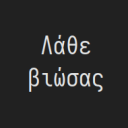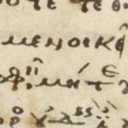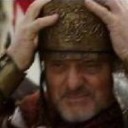"School of Athens" - Diogenes the Cynic(?) and the Gesturers
-
-
Whether we identify one of those figures with Epicurus or not they are definitely composed as a pair. Raphael did preparatory sketches with those two. Plus they are definitely reacting to the figure on the steps with whom I find the most convincing argument to be Diogenes the Cynic with his cup, the last material possession of his. The figure to the left of Plato looks too much like Socrates to not be him (plus Socrates was "sanctioned" by the Church via Plato and Aristotle,if I remember correctly).
The questions remain, however, as to HOW the two figures on the steps are reacting to Diogenes. Favorably? Scornfully?
I think these figures are due some investigation (especially since 19th c. academics were equating each of them with Epicurus).
-
To help consolidate, here is my post with the relevant articles:
1)
RAPHAEL'S "SCHOOL OF ATHENS"
Author(s): Gertrude Garrigues
Source: The Journal of Speculative Philosophy , October, 1879, Vol. 13, No. 4 (October 1879), pp. 406-420 (Excerpt, p. 417)
Published by: Penn State University Press
Stable URL: https://www.jstor.org/stable/25667781
"Over his "Garden" in Athens might have been written the noble aphorism of Goethe, " Think of Living." Democritus had a glimpse of this high thought, Aristippus saw it "darkly," too, but to Epicurus is due its embodiment ? to his followers, alas, its prostitution.
Perhaps the finest episode of the picture, certainly the strongest antithesis, is the contrast of Cynicism and Epicureanism, as represented by their chief exponents. Lying negligently upon the middle step (Raphael was no ascetic) is Diogenes of Sinope. His eyes fixed upon a tablet which he holds in his hand, he is absorbed in thought. His drapery is scanty and poor, but he has not yet reached the lowest point of his voluntary destitution; his bowl stands on the step beside him. Mounting the steps we see a young man, handsomely dressed. He has heard of the congress of philosophers, it seems, and has come hither to seek a master. Meeting a stranger (Epicurus, also richly dressed) descending, he inquires of him, "Who is the greatest teacher here? Surely this man, who exhibits so much contempt for all the luxuries and gauds of life; who, solitary, has no need of companionship." Epicurus points to the triumvirate above, telling him not to stop on the way, but seek always the highest good; and bids him not to trust too much to an appearance whose only characteristic may be its singularity. We seem almost to hear the echo of words like unto these of Emerson: "It is easy in the world to live after the world's opinion; it is easy in solitude to live after our own; but the great man is he who, in the midst of the crowd, keeps, with perfect sweetness, the independence of solitude.""
So, Garrigues sees Epicurus as the figure descending the staircase and speaking to the person coming up the steps beside Diogenes. I do think having that reclining figure be Diogenes of Sinope makes the most sense. That cup beside him isn't hemlock (like the other recent author we found who says that's Socrates and his cup of hemlock). That's Diogenes last remaining possession before he was embarrassed by the child using his hands to scoop up water, then Diogenes throwing away his cup. **IF** there was no portrait bust for Raphael to go by, he could make Epicurus appear any way he wanted. I personally like the idea of the striding figure descending the steps rather than the pudgy wreathed librarian... even if he is a librarian.
2)
https://archive.org/details/ra…s01pass/page/128/mode/2up
Raphael d'Urbin et son père, Giovanni Santi by Passavant, Johann David, 1787-1861
See p. 128
(I'm using Google Translate to get this translation)
In the middle of the steps, Diogenes of Sinope, named the Cynic, lying negligently, holds a tablet in his hand, and seems to be meditating deeply, without taking care of the illustrious assembly which surrounds him.
This singular man (born 414 years BC), disciple of Antisthenes, founded the severe school of Virtue, which he interpreted as an absolute renunciation of the material things of life. He thus expressed the basis of his doctrine: “To need nothing is proper to the gods. To need only a little is to be like the gods. So we see near him his bowl, the only utensil he wanted to have - until he recognized its superfluity, seeing a child draw water from his hand to drink.
Contemporary with Cynicism and Stoicism, Epicureanism differed on several points. The founder of the Epicurean sect, Epicurus (born 34 ^ years BC, in Gargettus, near Athens) also tended towards personal contentment, but he sought happiness in the harmony of moral pleasures and sensual pleasures. The Epicurean practiced virtue and wisdom only in view of their consequences and as a means of pleasure; he lived soberly and fraternally, and mastered both joy and suffering.
The fresco shows Epicurus descending the steps of the estrade, he converses with Aristippus', named Metrodidactus, a young man with curly hair, in a rich costume, and he indicates to him with a gesture the proud Stoic, disdainful of sensual pleasures.
The Greek genius, in search of a solution to the universal enigma, had exhausted itself in these multiple attempts. When the great men disappeared, there remained only sects which crossed and clashed.
This confused transition is indicated by the young man leaning against the base of one of the columns of the vestibule. Equilibrium on one leg, the other leg crossed in the air, he writes on his knee, not what his own research has taught him, but what he has heard from here and there. 11 represents Eclecticism which begins.
But while Eclecticism grasps all that seems to it to be true in the different systems, Skepticism, emerging at the same time, goes so far as to maintain that one can prove the falsehood of all established truth - a tendency which would have as a result the annihilation of all science, of all philosophy.
Pyrrho d'Elis (born 3M years BC) is the representative of this skeptical philosophy, which has even been given its name (Py rr honism). ^ E will not be accused of levity, if we designate , as Pyrrho, the standing and inactive philosopher, who leans against the base of a column and looks sarcastically into the book written by the young eclectic.
Standing next to him, the philosopher who, by a movement of hesitation, turns his head to one side and the body to the other side, must be Archilaus of Pitane (born 318 years BC), the founder of the new Academy, whose theory leaned towards Skepticism, the practice towards Stoicism. In general he only concluded with problematic knowledge, and, as all reason is subject to contradiction, he believed he should refrain from any decided adhesion.
I like the idea of Epicurus taking center stage, so to speak. And it would make sense that Pyrrho is nearby Epicurus since Epicurus had some degree of respect for him. They could be placed together.
3)
https://www.researchgate.net/p…7s_%27School_of_Athens%27
Codes and Messages in Raphael's 'School of Athens'
August 2016
State: In Progress
Authors: John Douglas Holgate, St George Hospital
-
I'd like to propose that these two characters represent the Cynics CRATES OF THEBES, teacher of the Stoic Zeno of Citium, and his wife HIPPARCHIA OF MARONEIA.
The bald, bearded male in orange standing above them strikes me as being ZENO OF CITIUM, who rose in popularity above his teacher. There is further consistency if we assume the figure in the very back of the row (depicted elsewhere) to be Antisthenes. This entire side represents Cynics and Stoics, if that speculation is accurate.
-
This entire side represents Cynics and Stoics,
That's one of the factors that would dispose me to think that Raphael balanced that with the side on the left being Epicurean.
Is it possible that there is a time element with the figures outward from the center are the oldest in Greek history, with those nearer the center being ranked not only in significance but also to a degree in time? In other words, outside of the central pair and the two groupings immediately around them, are any of the figures arranged further out (to the left, right, and foreground) visibly identifiable as being significantly LATER than the relatively early Stoics and Epicureans? I would tend to think that as a thumbnail summary most people consider Plato and Aristotle to be of most significance in history, with the Stoics and Epicureans immediately following/carrying forward their differences, and that everyone else (even Socrates) was a forerunner of this great Plato-Aristotle-Stoic-Epicurean axis.
Unread Threads
-
- Title
- Replies
- Last Reply
-
-

-
Diogenes Laertius Book X - public domain translations 3
- TauPhi
April 16, 2025 at 9:10 AM - General Discussion
- TauPhi
April 18, 2025 at 7:19 AM
-
- Replies
- 3
- Views
- 213
3
-
-
-

-
New Religious Landscape Study from Pew Research 28
- Don
February 26, 2025 at 10:40 PM - General Discussion
- Don
April 17, 2025 at 4:32 PM
-
- Replies
- 28
- Views
- 2.3k
28
-
-
-

-
"Voices From The Ancient World" Greek and Latin Reference Site
- Cassius
April 17, 2025 at 8:38 AM - General Discussion
- Cassius
April 17, 2025 at 8:38 AM
-
- Replies
- 0
- Views
- 128
-
-
-

-
Life Found Elsewhere? 7
- kochiekoch
April 17, 2025 at 6:10 AM - General Discussion
- kochiekoch
April 17, 2025 at 8:33 AM
-
- Replies
- 7
- Views
- 189
7
-
-
-

-
Must an Epicurean believe in gods? 14
- Rolf
April 15, 2025 at 5:24 PM - General Discussion
- Rolf
April 16, 2025 at 7:11 PM
-
- Replies
- 14
- Views
- 441
14
-

